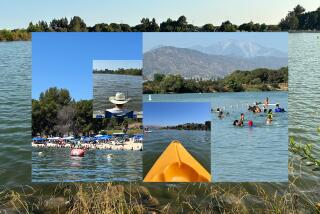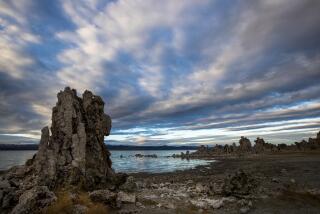HIDING CLOSE BY : Tucked in a canyon amid the Santa Monica Mountains, Malibou Lake has managed to avoid the nearby urban sprawl.
- Share via
Edmond Jeffery arrived in Malibou Lake with 25 feet of scaffolding and a secret atomic process for making rain.
Two years of drought had kept the lake bone-dry. The people of this small town in the Santa Monica Mountains were tired of staring at dust, at boat docks standing naked as skeletons. Nature had robbed them of their watery jewel.They paid Jeffery $250, plus room and board, to make things right.
The bearded ex-pilot proclaimed: “It’ll rain in seven days.”
That was 1961.
These days, the lake runs high and no one thinks about Jeffery. He is a blip in the town’s folklore. But the tale of this rainmaker, both quaint and eccentric, tells something of Malibou Lake. In many ways, nothing has changed since.
The same road, two lanes crumbling at the edges, winds into town. Not so much as a gas station or convenience store marks the way. Chaparral and live oak still dominate the hillsides, with houses clustered near the water.
That’s the peculiarity of this place. No crime. No sidewalks. Seven miles from the Ventura Freeway, not far from Agoura’s huddled tracts, Malibou Lake clings to the past.
This is a community of several hundred writers, actors, retired folks and business executives. Many of them work in the city and commute an hour or so home. Mountains encircle their small, rugged valley. No road signs mark the turnoff from the main road.
So, over the years, only tidbits of urban madness have found their way here. Odd happenings and strange visitors. People like Edmond Jeffery. His story--along with the story of this town--begins at the beginning.
Billions of years ago, soupy prehistoric seas nurtured organic compounds that, in turn, formed the first living cell. This mix eventually produced humans.
Malibou Lake evolved much the same way.
In 1923, state workers built a 44-foot-high dam across converging creeks, the Medea and the Triunfo. A body of water was born. In Southern California, a lake means one thing: lakefront property.
At first, construction was limited to vacation cabins. Clark Gable and Carole Lombard sought respite here in the ‘30s and ‘40s. W.C. Fields visited often. A private clubhouse was erected, offering such diversions as boating, fishing and target-shooting.
Malibou Lake continued as a celebrity resort for many years. But as postwar Los Angeles filled valleys and spilled over hills, covering more and more of the land, some people got the idea of staying year-round. Real estate prices had remained relatively cheap: $5,000 bought a hillside lot as late as 1960.
So houses replaced many of the cabins. A ranch-style here, a clapboard there. Such homes stood eaves-to-eaves, but the place never lost its country feel, the coveys of quail scurrying across hills, the eucalyptus trees that give afternoon shade.
And there was always the lake. People like to see it sparkling outside their living-room window. Its allure remains strong enough to outweigh natural hardships. Winter storms bring a threat of flood. Longtime residents have dug themselves out of the mud more than a few times. In summer, the hills turn dry as kindling. Sugarloaf, a proud butte overlooking town, has been known to toss boulders at the houses below.
Townfolk feign indifference. You can see it in a local man’s smile as he recalls a 1955 brush fire that destroyed 250 surrounding acres. The people of Malibou Lake wear such calamities as a badge of their isolation, the gift the dam brought them.
But dams can be fickle. Some can last 50 years without tending. Others need continual repairs.
In 1959, state officials wanted to inspect Malibou Dam. They drained two-thirds of the lake, expecting winter’s rain to refill those 20 million gallons. No rain came. Edmond Jeffery was summoned.
His arrival raised quite a hubbub. Every morning, he placed “radiation” chemicals atop his tower. At night, he burned another secret mixture in stoves on the ground.
Jeffery claimed that he had learned his craft from a man named Charles Mallory Hatfield, who according to a 1961 Times article “died in 1958, 42 years after he assertedly caused a San Diego cloudburst.”
The people of Malibou Lake regarded Jeffery with mixed emotions.
“I remember a local youngster walked by and the fellow told him, ‘See that little cloud up there? It took me two hours to make that one.’ It was kind of funny,” says Gordon Thomas, a longtime resident.
Others grumbled. “This makes us look like a bunch of nuts,” one man said.
Not that Malibou Lake worries about maintaining its reputation. These people don’t want any reputation at all. As the urban sprawl creeps closer with each condominium, each strip mall, they are feeling pressured.
“It’s a private lake,” a local man bristles. “There’s no need for anyone to know about it.”
Especially if that anyone is a reporter snooping around, asking questions.
“I don’t trust you,” Beatrice Read says. She arrived three decades ago. “If you write about us, people will come here.”
If this attitude lacks warmth, know that Malibou Lake isn’t the chummiest of communities, even among residents. Blame the architecture. People do their shopping in nearby suburbs. There is no central plaza or roadside diner. Other than the clubhouse--open to some, not others--there is nowhere to gather for the daily business of gossip.
Such transactions take place during small, weekly card games or on the street. Morning strolls are popular, walks along narrow roads where dogs run loose. Neighbors chat. The contact is fleeting.
“Everyone knows their neighbors. But overall, people keep to themselves,” Valerie Harris explains. “They’ve moved out here for privacy, so there isn’t a lot of visiting or hanging out.”
In fact, they can’t even agree on what to call themselves. Outsiders refer to the place as Malibou Lake. It’s not that simple.
Malibu (with a “u”) Creek flows from Malibou (with an “ou”) Dam. That’s the native American spelling. The lake is referred to as Malibu or Malibou, depending on whom you ask.
Residents who live on the lakefront refer to themselves as Malibou Lake. The people who live in the hills call their neighborhood Malibu Lakeside.
There will be a quiz on this later.
The division between lake folks and lakesiders extends beyond semantics. Lake residents own their houses, while a corporation owns the land. It’s a complex arrangement of membership dues and common shares. More importantly, these prime lots--and the stately Malibou Lake Mountain Club--are gated off from lakesiders.
“It’s two different communities,” says Nan Carlson, who lives on the private Lake property. “We have our club functions, our Christmas programs and picnics during the summer. We have Monday night card games. Of course, we invite Malibu Lakeside people if we know them.”
Indeed, lakesiders need an invitation simply to dip their toes in the water. Harris, who lives outside the fence, says: “There’s kind of a snob thing going. They don’t even like us to refer to ourselves as Malibou Lake.”
If ever an activity unified this town, it came in May, 1961, when all eyes turned skyward. Jeffery began burning chemicals and, four days later, clouds drifted overhead. Someone said it was drizzling over in Seminole Hot Springs. Someone else reported that a few drops fell in Agoura.
“The first rain will be showery,” Jeffery explained. “Everything is going along just as I expected.”
County officials weren’t so certain. They fretted about the smoke that Jeffery was releasing.
The rainmaker brushed away such concerns, saying: “We’ll just say we’re fighting mosquitoes with our chemicals.”
Secret “atomic” concoctions were merely the beginning of a long, strange decade for Malibou Lake. The 1960s brought motorcycle gangs and hippies. The Grateful Dead came here, as did the Byrds. Rumor has it that Charles Manson camped in nearby hills.
“At that time,” Thomas recalls, “we were looked upon as a poor man’s Topanga Canyon.”
The freaks and vagabonds, as they are wont to do, eventually drifted away. Some young families moved in. They brought nicer cars to put in their driveways because this had become a more affluent community, with cabins selling for $300,000 and larger houses valued in the millions. Mostly, the old and predominantly white guard remained with their old-fashioned ways.
“The same people live here. They just got older,” says Doug Barnard, who grew up around these parts. “Not very much changes.”
Those intrusions that do arrive, come in the name of progress. Construction to the northwest sends cubic yards of dirt down the Medea and Triunfo creeks. Lake residents pay for dredging lest their lake become a giant sandbox. At some times of year, like now, the water sits muddy-brown.
And, recently, lakesiders have been fighting a developer. While nearby suburbs grapple with apartment complexes and block-long malls, these homeowners gnash their teeth over a builder who wants to erect 15 houses on a vacant lot.
In fact, the people of Malibou Lake seem to prefer natural catastrophe to meddlesome outsiders. No less than the U.S. Army Corps of Engineers, the state Department of Fish and Game and the state Department of Water Resources preside over the lake. Residents say that erecting a simple back-yard dock can be nightmarish.
“They all need permits. When we try to ask questions, these people never return our calls,” says Robert McLaughlin, a lake resident for nearly four decades. “It wasn’t like this before.”
Even police seem largely unnecessary here. Years back, when local kids took to vandalizing, residents devised a solution: they hired the very same kids to watch the neighborhood. It worked. When locals broke into a car at Thomas’ house, he also took matters into his own hands.
“We knew who it was,” he says. “We straightened them out.”
Sheriff’s deputies are rarely called. In fact, a resident says, the last time a patrol car came this way, it backed over an embankment and had to be towed out.
The only time that outside help is truly sought is during a flood.
Which brings us back to water. If you need any more images of Malibou Lake, any more mental keepsakes, try these: When the lake flooded during record rains last February, Barnard recalls watching a dock, torn loose from its pilings but still equipped with patio furniture, drift over the dam.
“If there had been some guy on there toasting his fortune,” he says, “it would have been a scene from a Fellini movie.”
Down the road, Gordon Jackson was prepared. Valuable items, such as antique carousel horses, had been moved upstairs. The living-room floor had been converted to brick. Straps had been fastened along the ceiling so that furniture could be suspended above incoming waters. Which, in turn, brings us back to Edmond Jeffery.
By the seventh day of his efforts, Malibou Lake remained dry as dry. But the next morning, a light drizzle fell.
Weather bureau officials insisted that these sprinkles resulted from a storm front that stretched from San Francisco to San Diego.
Jeffery disagreed.
“I know I did it,” he said.
There was talk of paying the rainmaker $2,000 to continue his work until the lake was filled. Club members decided otherwise. Jeffery left town.
A week later, Thomas recalls, a drenching storm blew in.
More to Read
Sign up for Essential California
The most important California stories and recommendations in your inbox every morning.
You may occasionally receive promotional content from the Los Angeles Times.










